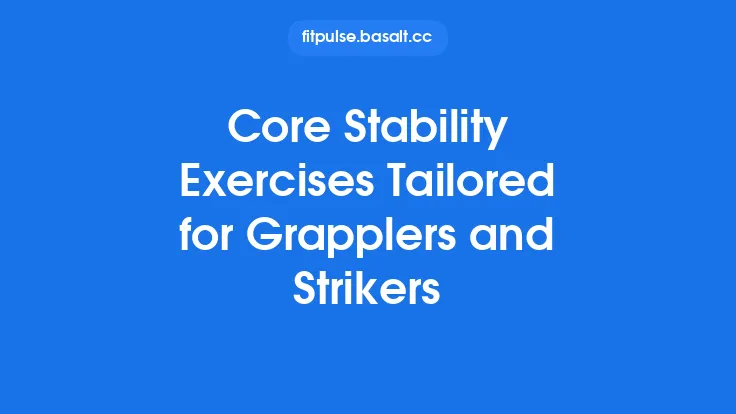Core stability is the foundation upon which virtually every movement pattern rests, from the simplest daily tasks to the most demanding athletic feats. When the core functions optimally, it provides a rigid yet adaptable platform that allows the limbs to generate force efficiently, protects the spine from excessive stress, and enhances overall balance and coordination. Because each individual brings a unique combination of anatomy, movement habits, training history, and performance goals, a one‑size‑fits‑all approach to core development often falls short. Tailoring a core‑strength program to specific objectives—whether the aim is to improve postural control for a desk‑bound professional, increase rotational power for a golfer, or enhance pelvic stability for a dancer—ensures that the training stimulus aligns precisely with the desired functional outcomes.
Understanding the Core: More Than Just “Abs”
A common misconception is that the core consists solely of the rectus abdominis—the “six‑pack” muscle. In reality, the core is a complex, inter‑connected system that includes:
| Structure | Primary Role | Typical Activation Patterns |
|---|---|---|
| Transversus Abdominis (TA) | Deep stabilizer that creates intra‑abdominal pressure | Isometric, low‑intensity contractions during most static postures |
| Internal & External Obliques | Trunk rotation and lateral flexion; assist in spinal compression | Dynamic, especially during rotational or side‑bending movements |
| Multifidus | Segmental spinal stability; fine‑tunes vertebral alignment | Low‑level, continuous activation during standing and walking |
| Erector Spinae (lumbar region) | Extends the spine; resists flexion loads | Engaged during hip hinging, lifting, and postural maintenance |
| Pelvic Floor & Diaphragm | Regulate intra‑abdominal pressure; coordinate breathing with core tension | Co‑activate with TA during breath‑holding and heavy lifts |
| Hip Stabilizers (gluteus medius/minimus, deep rotators) | Transfer forces between lower and upper body; maintain pelvic alignment | Active during single‑leg stance, gait, and lateral movements |
Recognizing this breadth is essential for program customization: the relative emphasis placed on each component should reflect the client’s functional demands.
Conducting a Targeted Core Assessment
Before prescribing any exercise, a systematic assessment pinpoints strengths, weaknesses, and movement patterns that are most relevant to the client’s goals. A comprehensive core evaluation typically includes:
- Postural Screening
- Observe spinal curvature (lumbar lordosis, thoracic kyphosis) and pelvic tilt.
- Identify compensations such as anterior pelvic tilt that may predispose to low‑back stress.
- Static Stability Tests
- Plank Hold (forearm, side, and reverse variations) to gauge endurance of the anterior and lateral core.
- Dead‑Bug and Bird‑Dog for neuromuscular control of the TA and multifidus.
- Dynamic Stability & Motor Control
- Single‑Leg Squat or Lunge with trunk neutral to assess integration of hip and core stabilizers.
- Rotational Medicine Ball Throws to evaluate oblique activation and timing.
- Breathing Mechanics
- Diaphragmatic breathing assessment to ensure proper coordination between the diaphragm and TA, especially for athletes who require high intra‑abdominal pressure (e.g., weightlifters, martial artists).
- Functional Transfer Tests
- Standing Cable Rotation or Pallof Press to simulate sport‑specific or occupational rotational demands.
- Load‑Bearing Carry (farmer’s walk, suitcase carry) to test core stability under axial loading.
The data gathered from these assessments guide the selection of exercises, the order of progression, and the emphasis on particular core regions.
Principles of Personalized Core Programming
1. Goal‑Driven Exercise Selection
- Postural Correction – Prioritize deep stabilizers (TA, multifidus) and hip flexor/extensor balance.
- Rotational Power – Emphasize obliques, thoracic mobility, and anti‑rotation drills.
- Axial Load Tolerance – Integrate loaded carries, weighted planks, and heavy hip‑hinge patterns.
2. Load Management and Progression
Core training can be progressed along three axes:
- Intensity – Increase external resistance (e.g., weighted vests, medicine balls).
- Complexity – Add multi‑planar movements or unstable surfaces (e.g., BOSU, suspension trainers).
- Volume – Manipulate sets, reps, and hold durations to target endurance versus strength.
A typical periodization model for core stability might follow a micro‑cycle of 3–4 sessions, a meso‑cycle of 4–6 weeks focusing on a primary adaptation (e.g., endurance → strength → power), and a macro‑cycle of 6–12 months aligning with the client’s broader training calendar (competition, performance peaks, off‑season).
3. Integration with Whole‑Body Mechanics
Core stability does not exist in isolation. Effective programs embed core work within compound movements:
- Hip Hinge Patterns (deadlifts, kettlebell swings) reinforce lumbar stability under load.
- Squat Variations demand coordinated activation of the core to maintain trunk neutrality.
- Push‑Pull Chains (bench press, rows) require anti‑extension and anti‑flexion control.
Embedding core cues (e.g., “brace as if preparing for a punch”) during these lifts reinforces transfer to real‑world tasks.
4. Neuromuscular Timing Over Pure Strength
For many functional objectives, the timing of core activation is more critical than maximal force production. Training methods that enhance feed‑forward activation—such as pre‑activation drills before dynamic lifts—improve the ability to recruit the core reflexively when external forces arise.
Sample Personalized Core Programs
Below are three modular templates, each aligned with a distinct objective. All programs assume a baseline level of fitness and can be scaled up or down by adjusting resistance, tempo, or stability demands.
A. Postural Stabilization for Desk‑Bound Professionals
| Exercise | Sets | Reps / Hold | Progression Tips |
|---|---|---|---|
| Supine TA Activation (Heel Slides) | 3 | 12 each side | Add a light band around the knees for added hip activation |
| Standing Hip Hinge with Light Kettlebell | 3 | 10 | Increase kettlebell weight or perform on a wobble board |
| Wall Angel with Scapular Retraction | 3 | 15 | Hold the end position for 3 seconds |
| Side‑Plank with Hip Dip | 2 | 30 s each side | Add ankle weight or elevate the top leg |
| Seated Diaphragmatic Breathing + TA Brace | 2 | 5 min | Incorporate a 5‑second hold after each exhale |
Focus: Low‑load, high‑control movements that reinforce deep stabilizer recruitment and improve thoracic posture.
B. Rotational Power for Golfers and Throwers
| Exercise | Sets | Reps | Progression Tips |
|---|---|---|---|
| Cable Woodchop (Diagonal) | 4 | 12 each side | Increase cable tension; add a pause at peak rotation |
| Medicine Ball Rotational Throw (Standing) | 3 | 8 each side | Use a heavier ball; incorporate a step‑forward for momentum |
| Pallof Press with Lateral Walk | 3 | 10 steps each direction | Add a band around the knees for added hip challenge |
| Single‑Leg Romanian Deadlift (Bodyweight) | 3 | 10 each leg | Hold a light dumbbell; focus on maintaining a neutral spine |
| Anti‑Rotation Plank (Feet on Slider) | 3 | 30 s each side | Increase hold time or add a shoulder tap |
Focus: Dynamic anti‑rotation, controlled spinal loading, and coordinated hip‑core sequencing.
C. Axial Load Tolerance for Powerlifters and Strongmen
| Exercise | Sets | Reps / Hold | Progression Tips |
|---|---|---|---|
| Weighted Front Plank | 4 | 45 s | Add a weight plate on the back; progress to a single‑arm plank |
| Suitcase Carry (Heavy Dumbbell/Kettlebell) | 5 | 30 m each side | Increase load; incorporate uneven terrain |
| Barbell Rollout (Ab Wheel or Barbell) | 3 | 8 | Add a weight plate on the bar; increase range of motion |
| Deadlift with Core Cue (Brace & Hold) | 5 | 5 reps @ 70 % 1RM | Emphasize maximal intra‑abdominal pressure |
| Overhead Farmer’s Walk | 3 | 20 m | Use kettlebells or sandbags; focus on maintaining a neutral spine |
Focus: High‑intensity, load‑bearing core work that trains the spine to resist compressive and shear forces.
Monitoring Progress and Adjusting the Plan
A personalized program is dynamic; regular reassessment ensures continued relevance and effectiveness.
- Quantitative Metrics: Track plank hold times, weighted carry distances, and rotational throw velocities. Use a simple spreadsheet or a dedicated training app to log weekly changes.
- Qualitative Feedback: Ask clients about perceived stability during daily activities (e.g., “Do you feel steadier when reaching for objects on a high shelf?”). Subjective improvements often precede measurable gains.
- Biomechanical Re‑Evaluation: Every 4–6 weeks, repeat key assessment drills (e.g., dead‑bug, single‑leg squat) to detect changes in motor control.
- Periodization Adjustments: If a client reaches a plateau in endurance, shift the focus to strength for 2–3 weeks, then return to endurance. This “undulating” approach prevents adaptation stagnation.
Tools and Technology for Enhanced Customization
While a solid foundation can be built with minimal equipment, certain tools can refine the personalization process:
| Tool | Application | Benefits |
|---|---|---|
| Force Plates | Measure ground reaction forces during single‑leg tasks | Quantify asymmetries and load distribution |
| Surface EMG | Monitor activation patterns of TA, obliques, and multifidus | Provide real‑time feedback for cue refinement |
| Inertial Measurement Units (IMUs) | Track trunk rotation velocity and stability during dynamic lifts | Objective data for rotational power programs |
| Mobile Apps (e.g., Coach’s Eye, MyFitnessPal) | Log sessions, video analysis, and nutrition (if relevant) | Centralized data for holistic program management |
| Adjustable Resistance Bands | Offer scalable load for anti‑rotation and activation drills | Portable, cost‑effective progression tool |
Incorporating technology is optional but can accelerate the feedback loop, especially for athletes seeking marginal gains.
Common Pitfalls and How to Avoid Them
- Over‑Emphasizing “Abs” Work
- Solution: Balance anterior, lateral, and posterior core exercises; include hip and lumbar stabilizers.
- Neglecting Breathing Coordination
- Solution: Teach diaphragmatic breathing and cue “brace as you exhale” during heavy lifts.
- Progressing Too Quickly on Load
- Solution: Prioritize mastery of movement patterns before adding weight; use the “10‑second rule” (maintain form for at least 10 seconds under load).
- Isolating Core Training from Whole‑Body Movements
- Solution: Integrate core cues into compound lifts and functional tasks to promote transfer.
- Failing to Re‑Assess
- Solution: Schedule regular reassessments and adjust the program based on objective and subjective data.
Final Thoughts
Optimizing core strength for stability is a nuanced endeavor that thrives on personalization. By dissecting the anatomy of the core, conducting targeted assessments, applying principled programming, and continuously monitoring outcomes, practitioners can craft bespoke regimens that align perfectly with each individual’s functional objectives. Whether the goal is to sit upright at a desk without fatigue, generate powerful rotational force on the fairway, or safely handle heavy loads in the gym, a well‑designed, customized core program provides the stable platform necessary for sustained performance and long‑term musculoskeletal health.





